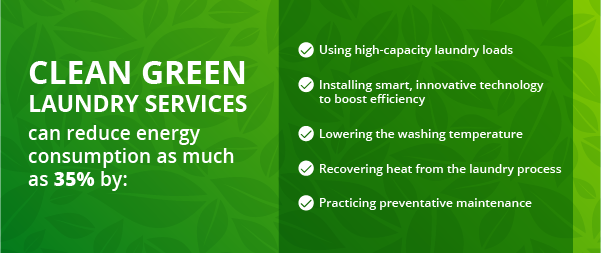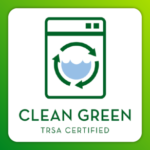How Clean Green Laundering Promotes COVID-19 Safety in Workplaces
As most people realize by this point, managing the COVID-19 (Coronavirus) crisis requires a multi-pronged approach. Surfaces must be cleaned, hands must be washed, faces must be covered—and those are only a few of the customary safety measures for preventing infection. One of the more overlooked types of infection hazards is the clothing we wear in the workplace. Keeping employee apparel and uniforms clean is vital to curtail the risk of spreading COVID-19 among personnel and customers.
There are several approaches for achieving this goal, but, as we will see, your best strategy is to rely on a third-party organization that specializes in Clean Green laundering services. These services can wash and sanitize your employee’s uniforms to eradicate any traces of the COVID-19 virus while minimizing negative impacts to the environment.
Clothing and COVID-19
Does the presence of COVID-19 on clothing really pose a workplace hazard? It is well established that the virus can spread through exposure to extremely tiny respiratory droplets from an infected person. These droplets, which can be expelled from the mouth by coughing, sneezing, talking, or just breathing, can linger in the air or collect on surfaces. How long the virus can survive in the air or on surfaces—and remain infectious—depends on a variety of factors, including the temperature of the immediate area.
We know that the COVID-19 virus tends to survive longest—up to a week—on smooth, non-porous surfaces. The good news is that the clothing we wear is generally far from an ideal refuge for the virus. This has been confirmed by research. One scientific study found that the COVID-19 virus can be detected on fabric for up to two days at room temperature, which is a considerably shorter lifespan than the virus tends to enjoy on plastic and metal surfaces.
However, it’s also true that even this relatively brief two-day window still poses a health risk. If an employee’s uniform or apparel has become tainted by COVID-19, then it’s possible that the virus can infect them or others. That’s just one more reason why it is a sound practice to keep plenty of replacement uniforms onsite so your employees can change out of dirty apparel immediately. It’s also why you need to ensure that company uniforms are correctly laundered to remove all traces of COVID-19.
Safe Laundry Practices

Understanding proper handling and washing procedures for dirty workplace uniforms can significantly reduce your employees’ risk of becoming infected with COVID-19 and spreading it to others. Fortunately, the Centers for Disease Control and Prevention (CDC) has issued sensible guidelines for the safe management of washable fabrics in the COVID-19 era. These guidelines include the following tips:
- Ensure that persons handling dirty uniforms wear disposable gloves at all stages of the process.
- Never shake dirty uniforms. Doing so can release the COVID-19 virus into their air, where it can infect others.
- Regularly disinfect containers used for the storage and transportation of used uniforms. Consult the EPA’s list of approved COVID-19 disinfectants for more information.
- Wash and dry uniforms with the warmest setting possible for the type of clothing being washed. Heat rapidly kills the COVID-19 virus.
Many businesses find it difficult to manage their laundering burdens, even if they succeed in complying with CDC guidelines. It’s not uncommon for businesses to require their employees to launder their own uniforms, but there are several issues with this approach. One problem is that some states, such as California, require businesses to reimburse employees for expenses such as these. Another issue is that employees simply may not be washing their uniforms correctly.
Many other businesses clean employee uniforms onsite. This approach also has its shortcomings, not the least of which is the fact that conventional laundering practices place undue burdens on the environment and enlarge a business’s ecological footprint.
There is another method, however. Outsourcing laundry responsibilities to a third-party organization that specializes in Clean Green washing practices helps businesses avoid issues like these and ensure that their personnel has ready access to clean, safe apparel.
How Clean Green Laundry Services Can Help

The Clean Green Certification program launched by the Textile Rental Services Association (TRSA) grants official recognition to those linen, uniform, and facility services that have established eco-friendly procedures for the laundering of uniforms, clothing, and other fabrics. To attain this sought-after certification, a laundry service must meet certain best management practices (BMPs), which includes reaching certain benchmarks in water efficiency and energy consumption.
How does a Clean Green Certified service achieve these environmentally friendly goals? There are a variety of applicable BMPs, and laundries are encouraged to implement as many as possible. Recognized BMPs include:
- Use of NPE-free detergents
- Energy-efficient lighting at the cleaning facility
- Implementing water reuse technology
- Implementing a recycling program
- Implementing a wastewater pre-treatment program
- Optimizing delivery truck routes for fuel efficiency
- Undergoing an energy audit every three years
Turning to a Clean Green Certified laundry service gives you the best of both worlds: clean, safe uniforms processed by experienced professionals as well as a substantial reduction in your company’s impact on the environment.
Release date: 12/15/2020
Contact: Jerry Martin, V.P. of Sales & Marketing (949) 996-8976
Source: Environment + Energy Leader
By: Jerry Martin, Vice President of Sales & Marketing, Prudential Overall Supply
